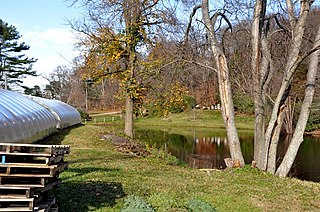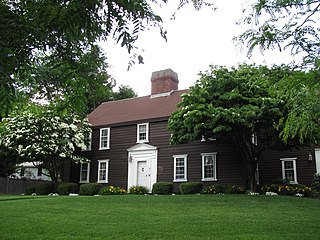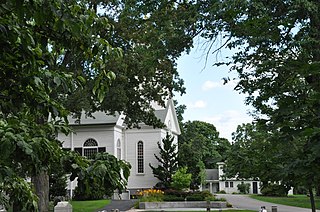
Malbone is the oldest mansion in Newport, Rhode Island. The original mid-18th century estate was the country residence of Col. Godfrey Malbone of Virginia and Connecticut. The main house burned down during a dinner party in 1766 and the remaining structure sat dormant for many years until New York lawyer Jonathan Prescott Hall built a new roughly 5,800 sq ft (540 m2) castellated residence directly on top of the old ivy-covered ruins.
East Parish Burying Ground, also known as Centre Street Burying Ground or Centre Street Cemetery, is an historic cemetery located at Centre and Cotton streets in the village of Newton Corner in the city of Newton, Massachusetts. On December 23, 1983, it was listed on the National Register of Historic Places. It has been called the "most important, the most evocative and also the most fragile historic site in the city."

Allandale Farm, also known as the John Harris House and Farm, and once as Faulkner Farm, is an historic farm at 284 Newton Street in Brookline and Boston, Massachusetts. The main farm house, built c. 1778 and extensively remodeled in 1976, is one of Brookline's few 18th-century houses. The farm is the last working farm in both communities; it was added to the National Register of Historic Places in 1985.

The Newton Theological Institution Historic District is an historic district in the village of Newton Centre in Newton, Massachusetts. It encompasses not only the campus of the Newton Theological Institution, now known as the Andover Newton Theological School, but also a cluster of fashionable 19th century houses north of the campus, on Herrick Road and Chase and Cypress Streets. The school was the first outside educational institution in Newton. The district was listed on the National Register of Historic Places in 1986.

The Samuel Gardner House is a historic colonial American house in Swansea, Massachusetts. This 1+1⁄2-story wood frame gambrel-roofed house was built c. 1768 by Samuel Gardner, whose father was the first English colonist to settle Gardner's Neck after its purchase from local Native Americans. It is a well-preserved 18th century farmhouse.

The Eaton-Moulton Mill is a historic industrial building at 37 Walnut Street in the Wellesley Lower Falls village of Wellesley, Massachusetts. The 2+1⁄2-story granite mill building was built c. 1853 by the firm of Reuben Ware and William Clark, manufacturers of papermaking machinery. The building is distinctive for its use of stone, a relatively uncommon construction material in this area. The Lower Falls area of Wellesley and Newton developed as a papermaking center in the 18th century, and began transitioning from handmade methods to machine methods producing rolls of paper in the 1830s. Ware and Clark were at the forefront of this transition, establishing a machine shop in 1832 where the manufactured equipment for this new process. This building was built for them in 1853, and continued under Eaton and Moulton and other owners until papermaking declined. The building now houses commercial office space.

The Clark–Eames House is a historic house located at 230 Middlefield Road in Washington, Massachusetts. Probably built around 1790, it is one of the town's few surviving 18th-century houses. It was listed on the National Register of Historic Places in 1986.

The Fuller–Bemis House is a historic house at 41–43 Cherry Street in Waltham, Massachusetts. The 2+1⁄2-story wood-frame house was built c. 1776, and is one of Waltham's few 18th century houses. It was built when the south side, where it is located, was still part of Newton. It was converted into a two-family structure in the 19th century. Its relatively plain Georgian styling sets it apart from the later 19th century housing that surrounds it.

The Hammond House is an historic house located at 9 Old Orchard Road in the village of Chestnut Hill in Newton, Massachusetts. With an estimated construction date of 1645-1730, it is believed to be the oldest house in Newton. It is also a rare example of a First Period house that was started as a single cell, that was expanded to five bays later in the First Period; such expansion usually took place later in the 18th century, during the Georgian period. The house has been extended multiple times over the intervening centuries; the original core now lies just east of the main entrance. The original house was built by Hon. Ebenezer Stone when he moved from the Stone homestead at Mount Auburn in Watertown.

The house at 173–175 Ward Street in Newton, Massachusetts is one of the city's few federal style houses. Built c. 1800, it is a 2+1⁄2-story wood-frame structure with clapboard siding and twin rear wall chimneys. The house has a five-bay facade with windows framed by narrow moulding. The main entrance is flanked by paired pilasters surrounding sidelight windows, topped by an entablature. The house was built by Charles Hyde and was involved in property disputes attending the construction of tunnels in the area in the mid-19th century.

The Samuel Jackson Jr. House is a historic house located at 137 Washington Street in Newton, Massachusetts.

The Kingsbury House is a historic house at 137 Suffolk Street in the Chestnut Hill section of Newton, Massachusetts. The oldest part of this 2+1⁄2-story timber frame may have been built as early as 1686; its exterior styling suggests a construction date in the early 18th century, but the earlier structure may have been incorporated in new construction at that time. The house is one a few First Period houses in Newton, and was associated for many years in the 19th century with the Kingsbury family, who were major landowners in the Chestnut Hill area.

The Newton Lower Falls Historic District encompasses the historic colonial village center of Newton Lower Falls, on the west side of Newton, Massachusetts. This area lies north of Washington Street, along Concord and Grove Streets, between Washington and Hagar Streets. The district was listed on the National Register of Historic Places in 1986.

The Old Chestnut Hill Historic District encompasses the historic residential heart of the Newton portion of Chestnut Hill, Massachusetts. When first listed on the National Register of Historic Places in 1986, the district extended along Hammond Street, between Beacon Street and the MBTA Green Line right-of-way, and along Chestnut Hill Road between Hammond and Essex, including properties along a few adjacent streets. The district was expanded in 1990 to include more of Chestnut Hill Road and Essex Road, Suffolk Road and the roads between it and Hammond, and a small section south of the Green Line including properties on Hammond Street, Longwood Road, and Middlesex Road. A further expansion in 1999 added a single property on Suffolk Road.

The Deacon John Staples House is a historic house at 1615 Beacon Street in the village of Waban in Newton, Massachusetts.

Whittemore's Tavern is a historic building at 473 Auburn Street in the Auburndale village of Newton, Massachusetts. It was operated as a tavern for a time in the 18th century, but it is now a private residence. The 2+1⁄2-story wood-frame house was built c. 1724, probably by William Robinson II, sone of one of Auburndale's early settlers. It served as a tavern in the 1760s, when Auburn Street was a major east–west thoroughfare. The asymmetrical window placement on the front facade suggests that the house may have been built in stages.

The Isaac Child House is a historic house at 209 Newton Street in Brookline, Massachusetts. With a documented history dating to the 1790s, it is one of Brookline's few surviving 18th-century houses. It was listed on the National Register of Historic Places in 1985.

West Roxbury Parkway is a historic parkway running from Washington Street in Boston, Massachusetts, where the Enneking Parkway runs south, to Horace James Circle in Brookline, where it meets the Hammond Pond Parkway. The parkway serves as a connector between Stony Brook Reservation and Hammond Pond Reservation. West Roxbury Parkway was built between 1919 and 1929 and added to the National Register of Historic Places in 2006. The parkway is distinctive in the roadway system developed by the Metropolitan District Commission beginning around the turn of the 20th century in that it was built in collaboration with the City of Boston, and is maintained by the city.

The Chesterfield Center Historic District is a historic district that encompasses the traditional village center of the town of Chesterfield, Massachusetts. The village is reflective of the town's 18th and 19th-century development as an agrarian hill community, with architectural styles before about 1850 predominating. The district was listed on the National Register of Historic Places in 2000.

The Moore Farm and Twitchell Mill Site is a historic property on Page Road in Dublin, New Hampshire. The 6.8-acre (2.8 ha) property includes an early 19th-century farmhouse, as well as the remnants of one of Dublin's earliest industrial sites. It lies just south of a bend in Page Road in southern Dublin, where Stanley Brook runs east-west along the south side of the road. In c. 1768 Samuel Twitchell, Dublin's second settler, built a sawmill that used Stanley Brook as its power source. This mill was the second established in what is now Dublin, after that of Eli Morse. It was used until the mid-19th century, and now only its foundations remain. The farmhouse of Samuel Moore was built in a glen on the south side of the brook c. 1812, and was a vernacular Cape style farmhouse. The farm was purchased in 1935 by William and Katherine Mitchell Jackson, and the house was moved about 100 yards (91 m) to the top of a rise where it has commanding views of Mount Monadnock. The house was restored and enlarged under the guidance of architects Bradley & Church and again renovated in 1951. The farm complex includes a barn that is contemporaneous to the house, and a caretaker's cottage that is a 1952 reconstruction of an earlier one destroyed by fire.






















